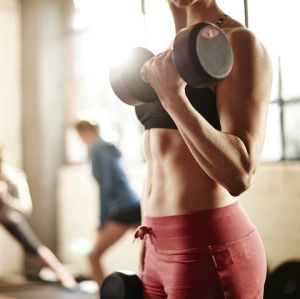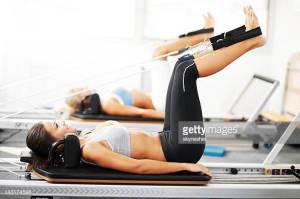It’s been just a little over a year since everything shut down on us and we were forced to see what the new normal brought for us. For those of us gym-goers, it meant figuring out the world of at home workouts. I’ve kept you guys updated on new programs and influencers I am following and what I think of different workouts I try. While I’ve learned a lot about myself through trying different at home workouts, and as I’ve mentioned here before, I have really found something that works for me, I’ve also learned a lot about the online space and the fitness community online. So today, I want to share with you guys some of the things I have learned about the at home workout world.
Titles are made to make you click
For those of us who have been navigating the internet for awhile, clickbait isn’t new. We are bombarded with titles made for us to click and read or watch all the time. The online fitness community is no different!
6 pack abs! Fat Burning Cardio Workout! Get fit Fast! Burn 600 Calories in 60 minutes!
We see these titles all the time.
There has been some debate online about the toxicity of such titles and if they really belong in the fitness community. Are they doing more harm than good? After all, they are often lying (you aren’t going to melt away fat by doing a 15 minute cardio workout and you aren’t going to spot reduce fat to get a six pack by doing the same ab routine for 14 days straight). Should these titles be allowed or could they be damaging to body image and promote body dysmorphia and disorders related to workout addiction.
The important thing to make note of here is that influencers are going to continue to make clickbait titles KNOWING THEY ARE DOING SO because how else are they going to get views? (At least for most of them, let’s be fair there are some gems out there who do not do this bu they are few and far between). To go viral, get popular, and stay relevent click bait titles are one of the few ways to garuntee a paycheck is coming in so they are going to continue.
What’s important to make sure is that you keep in mind that they are clickbait! Thy are created to get clicks but their claims are outlandish. If those types of titles trigger you, then it may be best to avoid them altogether, but if you can get passed the title and think its a great workout that makes you feel like you have really worked yourself and makes you feel good, do it, ignore the title, and just get it.
One of my favorite workouts is titled: “This Killer workout Torches Calories- 500 in 45 minutes”. Do I know it’s a totally clickbait title so it gets the 23 million views it has? Yes. But do I really enjoy the workout and throw it in my rotation when I’m looking for a good cardio session? Totally because it’s fun, effective, and while I won’t burn 500 calories I’ll still feel like I got a good workout and that is more important!
You aren’t going to burn the Number of Calories they say in the title
That brings us to our second point- you aren’t going to burn the number of calories the titles or captions say you will, you will likely burn less, but may burn more.
Why? There are two main reasons.
First, again, it’s about clickbait. Are you going to click a title that says “burn 200 calories in 45 minutes?” or “Burn 500 calories is 45 minutes?” Most people are going to go with the latter, so people are going to title their vidoes that!
Second, the number of calories you burn during a workout depends on a lot of factors including height, age, body fat percentage, muscle mass (muscle burns more calories than fat), gender, and intensity. What you burn during a workout is going to be completely different than what someone else, especially your “trainer” burns. You can’t judge your activity and burn based off of someone else and someone else’s body!
So I stress to ignore those titles or info boxes that say how many calories you are going to burn and just have fun with the workout instead. Aim to work hard and put your best food forward and don’t worry about the number of calories you are burning! Moving is good for the heart and the muscles and it also releases mood stabilizing endorphins, and that’s the most important thing!
HIIT workouts aren’t always High Intensity Training
High Intensity Interval Training, HIIT, is all the rage and so many influencers are creating HIIT workouts all the time, but the important thing to note is that often times, these aren’t actualy HIIT workouts.
It’s important to realize that HIIT means that during active intervals you are giving 100% of your ability to the activity for the duration of time and you should be worked to exhausted by the time of the rep. (Think running 100 meter sprints at the track). I don’t know about you guys, but when I am doing a HIIT workout I am giving it a good amount of effort, but very little am I going so intensely that I feel like I am dying! In fact, I would never compare the fatigue I feel during a HIIT video to that of running sprints at the track.
More often than not HIIT videos online or Moderate Intensity Interval Training, which is a worthy activity in itself and should not be put down in anyway, but it’s just a little less intense than High Intensity and more than Low Intensity. You can still get a great workout in, but I think it’s important we talk about what the different intensity levels actually are because the spreading of false information can be damaging to the fitness community.
A lot of influencers putting out workout content aren’t certified trainers
I have done so many actually really fun workouts from different influencers but I have come to realize in that time that so many of them, even the most popular of them, aren’t actually certified fitness trainers. Sure they might have backgrounds in certain sports and may actually have a good idea of what they are doing, but many of them do not hold a certificate as “trainers.”
Why does this matter? It means that their advise might not always be accurate and should always be taken with a grain off salt. You have to do your own research on who you are following and the advise you are being given. Does it meet up with what you have read and learned or does it seem too good to be true or outlandish?
For me, when it comes to lifting and resistance training, I try to only follow certified trainers (such as Caroline Girvan) so that way I know the exercise advise I am being given, the guidance I am recieving, and the technique I am being shown is accurate. For things like dance or kickboxing cardio, I don’t care if I am following a certified trainer as I have some background in both and feel my form and technique will keep me from getting hurt. When it comes to HIIT and cardio I mix it up a lot but again, I take everything I hear wiht a grain of salt and make sure I am following everything with good form and technique.
Be your own fact checker when it comes to navigating online fitness!
Do Not listen to the nutrition advise of fitness influencers
The number of influencers I see put out workout challenges and “Nutrition guides” scares me so much! We’ve already discussed how many of them aren’t certified fitness trainers, but usually NONE of them are certified Nutritionists or Dieticians and yet they are claiming to have a nutrition plan that will work for you?
I have seen so many low carbohyrate meal plans that are suggested next to high cardio workout plans or low fat diets for slim down programs that I want to scream! Please, if you take anything away from anything I have ever said in this blog let it be this: DO NOT EVER FOLLOW THE NUTRITION PLAN FROM SOMEONE WHO IS NOT CERTIFIED! Especially if that nutrition plan is the same for everyone!
Nutrition should be individualized. What you eat to lose weight or change your body composition is not the same thing your next door neighbor or your mother or father needs! An individualized plan should be created for you, not something created by someone who has never met you or talked to you.
If you are following a seasonal fitness challenge or program, that’s amazing and if you enjoy it and it suites you go for it, but if that plan comes with a nutrition plan, please please please seek advise from a certified professional instead. It;s one thing to get meal ideas from a plan, but another to follow calorie or macronutrient suggestions from someone who is not trained in nutrition!
So what is the take home message here? Take everything with a grain of salt. A lot of crazy claims and clickbait titales exist out there so people can make a living off of fitness youtube. Find the type of activities you like to do, things that you will be able to sticfk with, and as long as you are having fun, stick with it! Do background research on the types of training you should be doing, learn proper techniques, and stay educated. Track your own calroie burn based on your own biology ONLY if tracking is condusive to your progress. If tracking is not for you THROW IT OUT THE WINDOW AND JUST HAVE FUN!
Navigating the online fitness world can be overwhelming and slightly intimidating but there are a lot of great workouts out there to try and find what works best for you, so I say give it a go and see what you like!
Who are your favorite fitness influencers? Let me know in the comments below!
Until next time,
Kat
 Strength, or resistance training, is a type of exercise that causes the muscles to contract against a resistant force exerted on them. Muscles are caused to slightly tear, and as they regenerate and repair they grow stronger. This muscle breakdown is called catabolism with the regrowth called anabolism. This exercising causes an increase in strength, tone, and mass within these muscles. Resistance training can vary between self-body weight, rubber exercise bands, or actual weights. Resistance training can vary from weight lifting to Pilates depending on what your preferences are.
Strength, or resistance training, is a type of exercise that causes the muscles to contract against a resistant force exerted on them. Muscles are caused to slightly tear, and as they regenerate and repair they grow stronger. This muscle breakdown is called catabolism with the regrowth called anabolism. This exercising causes an increase in strength, tone, and mass within these muscles. Resistance training can vary between self-body weight, rubber exercise bands, or actual weights. Resistance training can vary from weight lifting to Pilates depending on what your preferences are. Getting started can be super intimidating, especially if you go to a gym with a lot of bulky guys who are always using the free weights. There are a lot of ways that you can start getting involved in more strength training.
Getting started can be super intimidating, especially if you go to a gym with a lot of bulky guys who are always using the free weights. There are a lot of ways that you can start getting involved in more strength training.